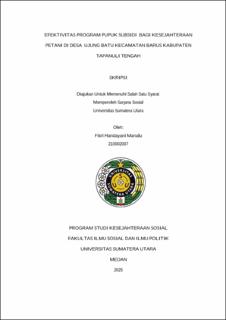Efektivitas Program Pupuk Subsidi Bagi Kesejahteraan Petani di Desa Ujung Batu Kecamatan Barus Kabupaten Tapanuli Tengah
The Effectiveness of the Subsidized Fertilizer Program for Farmer Welfare in Ujung Batu Village, Barus District, Central Tapanuli Regency

Date
2025Author
Manalu, Fitri Handayani
Advisor(s)
Sinaga, Randa Putra Kasea
Metadata
Show full item recordAbstract
Effectiveness is element in achieving predetermined goals or objectives in any
organization, activity, or program. organization, activity, or program. The program is said
to be effective if the objectives objectives that have been designed can be achieved with
appropriate results, both in terms of quality and quantity. quality and quantity. One of the
government programs designed to support the agricultural sector is the subsidized
fertilizer program, which has been implemented since the 1970s. The main objectives of
this program are to increase agricultural productivity, reduce production costs, and
encourage the welfare of farmers, especially rice farmers. welfare of farmers, especially
rice farmers. However, in its implementation, the subsidized fertilizer program program
often encounters various obstacles in the field, such as delayed distribution, inaccurate
targeting, and unequal access among farmers. Other problems include weak accuracy of
recipient data and farmers' lack of understanding of the use of digital systems such as e
RDKK (Group Needs Definitive Plan). This has led to sub-optimal utilization of subsidized
fertilizers which ultimately results in a decrease in yields and farmers' income. and
farmers' income. This study aims to determine effectiveness of the subsidized fertilizer
program for the welfare of farmers in Ujung Batu Village Barus Sub-district, Central
Tapanuli Regency This research uses a descriptive qualitative method to help the
researcher better understand the problem. Descriptive qualitative method so that
researchers better understand the problems that occur. Data collection techniques in this
research through interviews, observations, studies, and interviews. The results of the
interviews were then analyzed and conclusions were drawn. The conclusion obtained from
the results of this study is that the effectiveness of the subsidized fertilizer program has not
been running entirely and consistently for the welfare of farmers in Ujung Batu Village.
Effectiveness can be measured through the following 5 indicators: 1) program
understanding indicators show that all informants have understood this subsidized
fertilizer program, 2). Target accuracy shows that the distribution of subsidized fertilizers
is not right on target to farmers, there are still many active farmers who are not included
in the list of subsidized fertilizer recipients, 3). Timeliness indicates that the distribution of
subsidized fertilizers is not on time because it does not match the farmers' planting
schedule, 4). Achievement of objectives shows that only farmers who receive subsidized
fertilizer feel that the subsidized fertilizer program is achieved. 5). Real Change indicates
that the yield increase depends on the season and is affected by pests. Although the
subsidized fertilizer program has contributed positively to some farmers who received the
program, especially in easing production costs. But it has not been able to have an even
and significant impact on the welfare of farmers in Ujung Batu Village.
Collections
- Undergraduate Theses [1154]
